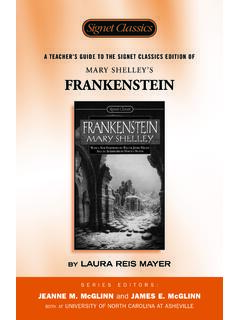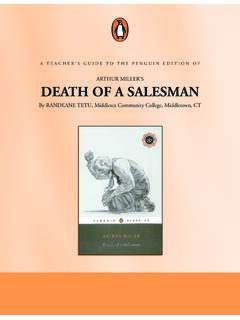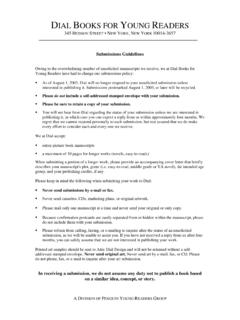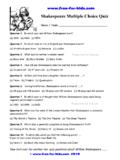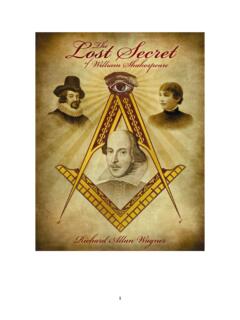Transcription of WILLIAM SHAKESPEARE’S HAMLET - Penguin Books
1 A TEACHER'S GUIDE TO THE SIGNET CLASSIC EDITION OF. WILLIAM shakespeare 'S. HAMLET . By PATTI C. McWHORTER, Cedar Shoals High School, Athens, GA. S E R I E S E D I T O R S : W. GEIGER ELLIS, , UNIVERSITY OF GEORGIA, EMERITUS. and ARTHEA J. S. REED, , UNIVERSITY OF NORTH CAROLINA, RETIRED. A Teacher's Guide to the Signet Classic Edition of WILLIAM shakespeare 's HAMLET 2. INTRODUCTION. The enigmatic qualities of shakespeare 's Prince HAMLET make this drama an appropriate choice for high school students who can evaluate and analyze the complexity of HAMLET 's situation, his motivations, and the choices and decisions he makes. Students are immediately intrigued by the play, especially if teachers introduce them to the complicated dilemma of Prince HAMLET before they begin reading. Once students are aware of HAMLET 's tragic story, they are compelled to learn what he decides to do and the consequences of his decisions. HAMLET is a monument of shakespeare 's talent, and as such. Teachers have the exciting opportunity to proceed in infinite directions in their teaching of the work.
2 The most meaningful focus, however, is to be found in studying the character of Prince HAMLET . As a young man, he is not much older than many of the teenagers who will the play. He is uncertain about how to deal with the loss of his father, confused about what his actions should be, and angry at most of the adults in his life. Students of all ability levels should be encouraged to interact with HAMLET on personal and analytical levels, providing a multi-dimensional reading experience. Included in this guide are activities for students of varying abilities, background on the play, an act-by-act synopsis, suggestions for organizing instruction, a list of journal writing topics, discussion questions, and activities for use before, during and after reading the play. HAMLET : AN OVERVIEW. SYNOPSIS. ACT I. Most of the action of play occurs in and around the castle at Elsinore in Denmark. King HAMLET is dead, and Prince HAMLET has returned to Denmark from school in Wittenberg, Germany, only to discover that Queen Gertrude, his mother, has married his Uncle Claudius.
3 Claudius has had himself crowned king. HAMLET is informed that what is apparently the ghost o f his dead father has appeared to the palace guards (I, ii). When he later confronts the ghost, HAMLET learns that Claudius murdered his father and hastily married Queen Gertrude (I, v). Throughout the play, the ongoing border disputes and political machinations amongst Denmark, Norway, and Poland serve as a backdrop for the action in the Danish court (I, ii; II, ii; IV, iv; V, ii). Prince Fortinbras, whose father was killed by HAMLET 's father, is a man of action, and his character serves as a foil to the contemplative Prince HAMLET . Polonius (Lord Chamberlain), his son Laertes and daughter Ophelia are also important characters in this drama. Polonius and Laertes are concerned about Ophelia's romantic involvement with Prince HAMLET and caution her against such a relationship. Polonius also provides fatherly advice to Laertes as he leaves for Paris (I, iii). ACT II. HAMLET 's emotional turmoil over his father's murder has left him in a visibly agitated condition, which some members of the court have interpreted as madness.
4 Claudius and Gertrude, concerned for his welfare, summon two of HAMLET 's oldest friends, Rosencrantz and Guildenstern, in the hopes that they can learn what is troubling him. (II, ii). HAMLET is immediately skeptical about their surprise visit. Anxious to confirm his own suspicions regarding the source of HAMLET 's trouble, Polonius arranges a meeting between Ophelia and HAMLET , as he is convinced that HAMLET 's love for Ophelia is the cause of his suffering (II, ii). When Polonius approaches HAMLET , HAMLET answers his questions although he believes Polonius to be a foolish old man. When a group of players arrives at the Danish court to entertain, HAMLET arranges for them to perform The Murder of Gonzago with the addition of lines HAMLET has written. What HAMLET hopes is to prove Claudius's guilt in the murder by watching his reaction to the drama the players will stage (II, ii). A Teacher's Guide to the Signet Classic Edition of WILLIAM shakespeare 's HAMLET 3. ACT III. When Rosencrantz and Guildenstern report back to Claudius that they have no explanation for HAMLET 's strange behavior, Claudius decides to eavesdrop with Polonius on the meeting between HAMLET and Ophelia.
5 Although HAMLET treats Ophelia irrationally, Claudius is suspicious of his behavior and makes plans to sent HAMLET to England (III, i). The players perform their drama in which the events portrayed, with HAMLET 's alterations, almost duplicate the circumstances surrounding King HAMLET 's death. HAMLET observes that Claudius is visibly upset by the play. When he leaves abruptly, Claudius confirms his guilt in the eyes of HAMLET and his friend, Horatio (III, ii). Out of concern for HAMLET 's welfare, Queen Gertrude meets privately with her son in her chambers. Polonius, however, is eavesdropping behind a wall tapestry. HAMLET 's rebukes cause Gertrude to cry out, and Polonius cries out as well, fearful for her welfare. Believing he has heard Claudius, HAMLET stabs through the tapestry, killing Polonius (III, iv). ACT IV. Polonius's death provides Claudius with the opportunity to send HAMLET to England, under the false pretense of protecting his life, when in reality, he has asked the King of England to kill Prince HAMLET (IV, iii).
6 Grief-stricken b y their father's death, Laertes and Ophelia solicit Claudius's assistance in finding his murderer (IV, v). Meanwhile, HAMLET sends word to Horatio that he has been taken prisoner by pirates who have returned him to Denmark and asks Horatio to join him (IV, vi). In order to remove HAMLET as a threat, Claudius now plans an exhibition duel in which Laertes will use a sword tipped with poison (IV, vii). ACT V. Ophelia's madness and subsequent drowning (IV, v; IV, vii) precipitate a confrontation between Laertes and HAMLET at her grave (V, I), but Claudius intervenes, privately assuring Laertes that his revenge will come in the duel which has been arranged. HAMLET seals the fate of Rosencrantz and Guildenstern by substituting another letter in the envelope which originally contained his own death orders, requesting that the King of England put them to death (V, ii). In spite of Horatio's concern, HAMLET agrees to the duel with Laertes and appears before the court as requested.
7 Not only does Claudius poison the tip of the sword, he also offers HAMLET a drink from a poison cup. Instead, Gertrude drinks from the cup and swoons from the effect of the poison, her dying words warning HAMLET of the plot against him. As the duel progresses, Laertes and HAMLET inadvertently exchange swords during a scuffle; consequently, both are mortally wounded, although HAMLET manages to fatally wound Claudius as well. As the play closes, Fortinbras arrives, victorious over Poland, and the dying HAMLET names him as the new king. Fortinbras pays tribute to HAMLET and arranges for an appropriate burial. ELEMENTS OF TRAGEDY IN HAMLET . By shakespeare 's time, the characteristics of tragedy in drama had been redefined. In the plays of the early Greeks, the tragic hero was a noble man who rose to the heights of success only to be plummeted to defeat and despair by his own tragic flaw, or hamartia. The plot structure in these early tragedies was relatively straightforward; the motive of the dramatist was to elicit pity and terror from the audience through empathy with the tragic hero.
8 What once had been a relatively simple form was gradually altered by playwrights to allow for more depth in characterization, more flexibility in plot structure, and the element of comic relief. HAMLET 's situation, for example, is considered a tragic one although it differs from the relatively simple plots found in the earlier Greek tragedies. He is a nobleman, revered by his countrymen, who strives to alter the world around him. Ultimately, he must forfeit his own life to see justice done. The plot that unfolds in shakespeare 's drama includes politics, murder, and domestic strife, but still evokes pity and terror in the audience, precisely as intended by the early tragedians. Students can analyze the elements of tragedy in HAMLET , comparing and contrasting Prince HAMLET 's plight with that of tragic heroes in Greek tragedies and in modern tragedies. Suggested modern tragedies for such a comparison include Death of a Salesman, by Arthur Miller, and Mourning Becomes Electra, by Eugene O'Neill.
9 Note: More detailed information about Elizabethan tragedy can be found in the Introduction by Edward Hubler in the Signet Classic edition of HAMLET . A Teacher's Guide to the Signet Classic Edition of WILLIAM shakespeare 's HAMLET 4. HISTORICAL CONTEXT OF HAMLET . Students will be interested to know that the story of Prince HAMLET was not original with shakespeare 's version. The basic plot was found in ancient stories which eventually made their way to Scandinavia, specifically Denmark. The Signet Classic edition contains more specific background on the origins of this story in "A Note on the Sources of HAMLET " and in Sylvan Barnet's prefatory remarks. Barnet also includes more general information about shakespeare , the Elizabethan theater, and the various texts of HAMLET . Suggested teaching strategies utilizing this information are included in the activities for use before reading the play. shakespeare 'S LANGUAGE. The enormous contribution which WILLIAM shakespeare has made to the English language is evidenced in the volumes of scholarly endeavor devoted to his body of works and in the direct and indirect allusions to his words in contemporary language and culture.
10 A richness in imagery and an ability to tap the depths of meaning in every word make the reading of a Shakespearean play more than memorable. Students who read HAMLET after reading other plays by shakespeare have often previously studied Elizabethan language and have some awareness of the changes which have taken place in word meaning and usage over the centuries. This background should serve them well as they become involved in the power of the language of HAMLET . The suggested activities which follow are intended to involve students in discovering the historical impact of shakespeare 's HAMLET and appreciating his extraordinary talent. ACTIVITIES FOR DISCOVERING AND APPRECIATING shakespeare 'S LANGUAGE. The imagery in the play which supports the impression of decay and corruption in Denmark is woven throughout the speeches and dialogue. Students can be divided into groups, each group assigned a different act and instructed to locate as many references to decay and corruption as possible.




